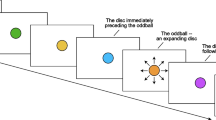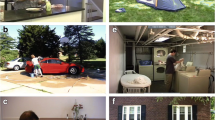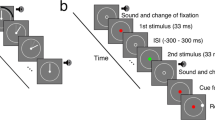Abstract
The perceived duration of time does not veridically reflect the physical duration but is distorted by various factors, such as the stimulus magnitude or the observer’s emotional state. Here, we showed that knowledge about an event’s termination time is another significant factor. We often experience time passage differently when we know that an event will terminate soon. To quantify this, we asked 33 university students to report a rotating clock hand’s duration with or without a termination cue that indicated the position at which the clock hand disappeared. The results showed that the presence of the termination cue dilated perceived durations, and the dilating effect was larger when the stimulus duration was longer, or the speed of the rotating stimulus was slower. A control experiment with a start-cue excluded the possibility that the cue’s mere existence caused the results. Further computational analyses based on the attention theory-of-time perception revealed that the size of dilation is best explained by neither an event’s duration nor the distance traveled by the clock hand, but by how long the clock hand spends time near the termination cue. The results imply that an event-termination cue generates a field in which the perceived time dilates.






Similar content being viewed by others
Data availability
Stimuli, data, and relevant codes for the experiments have been made publicly available via the Open Science Framework and can be accessed at https://osf.io/ys7tg/. The design and analysis plans for the experiments were not preregistered.
References
Agrillo, C., Ranpura, A., & Butterworth, B. (2010). Time and numerosity estimation are independent: Behavioral evidence for two different systems using a conflict paradigm. Cognitive Neuroscience, 1(2), 96–101.
Allan, L. G. (1979). The perception of time. Perception & Psychophysics, 26(5), 340–354.
Angrilli, A., Cherubini, P., Pavese, A., & Manfredini, S. (1997). The influence of affective factors on time perception. Perception & Psychophysics, 59(6), 972–982.
Assmus, A., Marshall, J. C., Noth, J., Zilles, K., & Fink, G. R. (2005). Difficulty of perceptual spatiotemporal integration modulates the neural activity of left inferior parietal cortex. Neuroscience, 132(4), 923–927.
Bangert, A. S., Kurby, C. A., Hughes, A. S., & Carrasco, O. (2020). Crossing event boundaries changes prospective perceptions of temporal length and proximity. Attention, Perception, & Psychophysics, 82(3), 1459–1472.
Birngruber, T., Schröter, H., & Ulrich, R. (2014). Duration perception of visual and auditory oddball stimuli: Does judgment task modulate the temporal oddball effect? Attention, Perception, & Psychophysics, 76(3), 814–828.
Block, R. A. (1992). Prospective and retrospective duration judgment: The role of information processing and memory (pp. 141–152). Springer.
Block, R. A., & Gruber, R. P. (2014). Time perception, attention, and memory: A selective review. Acta psychologica, 149, 129–133.
Block, R. A., & Reed, M. A. (1978). Remembered duration: Evidence for a contextual-change hypothesis. Journal of Experimental psychology: Human Learning and Memory, 4(6), 656.
Block, R. A., & Zakay, D. (1997). Prospective and retrospective duration judgments: A meta-analytic review. Psychonomic Bulletin & Review, 4(2), 184–197.
Boltz, M. G. (1995). Effects of event structure on retrospective duration judgments. Perception & Psychophysics, 57(7), 1080–1096.
Brainard, D. H., & Vision, S. (1997). The Psychophysics Toolbox. Spatial Vision, 10(4), 433–436.
Brown, S. W. (1985). Time perception and attention: The effects of prospective versus retrospective paradigms and task demands on perceived duration. Perception & Psychophysics, 38(2), 115–124.
Brown, S. W. (1995). Time, change, and motion: The effects of stimulus movement on temporal perception. Perception & Psychophysics, 57, 105–116.
Brown, S. W. (1997). Attentional resources in timing: Interference effects in concurrent temporal and nontemporal working memory tasks. Perception & Psychophysics, 59(7), 1118–1140.
Buhusi, C. V., & Meck, W. H. (2009). Relativity theory and time perception: Single or multiple clocks? PloS One, 4(7), e6268.
Buonomano, D. V., & Laje, R. (2011). Population clocks: motor timing with neural dynamics. Trends in Cognitive Sciences, 14(12), 520–527.
Cai, M. B., Eagleman, D. M., & Ma, W. J. (2015). Perceived duration is reduced by repetition but not by high-level expectation. Journal of Vision, 15(13), 19–19.
Cai, Z. G., Wang, R., Shen, M., & Speekenbrink, M. (2018). Cross-dimensional magnitude interactions arise from memory interference. Cognitive Psychology, 106, 21–42.
Casasanto, D., & Boroditsky, L. (2008). Time in the mind: Using space to think about time. Cognition, 106(2), 579–593.
Ceci, S. J., & Bronfenbrenner, U. (1985). Don’t forget to take the cupcakes out of the oven: Prospective memory, strategic time-monitoring, and context. Child Development, 56(1), 152–164.
Chang, C. J., & Jazayeri, M. (2018). Integration of speed and time for estimating time to contact. Proceedings of the National Academy of Sciences, 115(12), E2879–E2887.
Cicchini, G. M., Arrighi, R., Cecchetti, L., Giusti, M., & Burr, D. C. (2012). Optimal encoding of interval timing in expert percussionists. Journal of Neuroscience, 32(3), 1056–1060.
Coull, J. T., & Nobre, A. C. (1998). Where and when to pay attention: The neural systems for directing attention to spatial locations and to time intervals as revealed by both PET and fMRI. Journal of Neuroscience, 18(18), 7426–7435.
Coull, J. T., & Nobre, A. C. (2008). Dissociating explicit timing from temporal expectation with fMRI. Current opinion in neurobiology, 18(2), 137–144.
Coull, J. T., Vidal, F., Nazarian, B., & Macar, F. (2004). Functional anatomy of the attentional modulation of time estimation. Science, 303(5663), 1506–1508.
Dormal, V., Seron, X., & Pesenti, M. (2006). Numerosity-duration interference: A Stroop experiment. Acta Psychologica, 121(2), 109–124.
Faber, M., & Gennari, S. P. (2015). In search of lost time: Reconstructing the unfolding of events from memory. Cognition, 143, 193–202.
Fortin, C., Rousseau, R., Bourque, P., & Kirouac, E. (1993). Time estimation and concurrent nontemporal processing: Specific interference from short-term-memory demands. Perception & Psychophysics, 53(5), 536–548.
Franssen, V., & Vandierendonck, A. (2002). Time estimation: Does the reference memory mediate the effect of knowledge of results? Acta Psychologica, 109(3), 239–267.
Gibbon, J. (1977). Scalar expectancy theory and Weber's law in animal timing. Psychological Review, 84(3), 279.
Goldstone, S., & Lhamon, W. T. (1974). Studies of auditory-visual differences in human time judgment: 1. Sounds are judged longer than lights. Perceptual and Motor Skills, 39(1), 63–82.
Harris, J. E., & Wilkins, A. J. (1982). Remembering to do things: A theoretical framework and an illustrative experiment. Human Learning, 1(2), 123–136.
Herbst, S. K., Javadi, A. H., van der Meer, E., & Busch, N. A. (2013). How long depends on how fast—perceived flicker dilates subjective duration. PloS one, 8(10), e76074.
Hicks, R. E., Miller, G. W., & Kinsbourne, M. (1976). Prospective and retrospective judgments of time as a function of amount of information processed. The American Journal of Psychology, 89(4), 719–730.
Hollingworth, H. L. (1910). The central tendency of judgment. The Journal of Philosophy, Psychology and Scientific Methods, 7(17), 461–469.
Jazayeri, M., & Shadlen, M. N. (2010). Temporal context calibrates interval timing. Nature Neuroscience, 13(8), 1020–1026.
Kaneko, S., & Murakami, I. (2009). Perceived duration of visual motion increases with speed. Journal of Vision, 9(7), 14–14.
Kliegl, K. M., Watrin, L., & Huckauf, A. (2015). Duration perception of emotional stimuli: Using evaluative conditioning to avoid sensory confounds. Cognition and Emotion, 29(8), 1350–1367.
Körding, K. P., & Wolpert, D. M. (2004). Bayesian integration in sensorimotor learning. Nature, 427(6971), 244–247.
Kwon, O. S., & Knill, D. C. (2013). The brain uses adaptive internal models of scene statistics for sensorimotor estimation and planning. Proceedings of the National Academy of Sciences, 110(11), E1064–E1073.
Lejeune, H., & Wearden, J. H. (2009). Vierordt's The Experimental Study of the Time Sense (1868) and its legacy. European Journal of Cognitive Psychology, 21(6), 941–960.
Lhamon, W. T., & Goldstone, S. (1975). Movement and the judged duration of visual targets. Bulletin of the Psychonomic Society, 5(1), 53–54.
Li, Y., Mo, L., & Chen, Q. (2015). Differential contribution of velocity and distance to time estimation during self-initiated time-to-collision judgment. Neuropsychologia, 73, 35–47.
Makin, A. D., Poliakoff, E., Dillon, J., Perrin, A., Mullet, T., & Jones, L. A. (2012). The interaction between duration, velocity and repetitive auditory stimulation. Acta Psychologica, 139(3), 524–531.
Mattes, S., & Ulrich, R. (1998). Directed attention prolongs the perceived duration of a brief stimulus. Perception & Psychophysics, 60, 1305–1317.
Matthews, W. J., & Meck, W. H. (2016). Temporal cognition: Connecting subjective time to perception, attention, and memory. Psychological Bulletin, 142(8), 865.
Mioni, G., Stablum, F., Prunetti, E., & Grondin, S. (2016). Time perception in anxious and depressed patients: A comparison between time reproduction and time production tasks. Journal of Affective Disorders, 196, 154–163.
Miyazaki, M., Nozaki, D., & Nakajima, Y. (2005). Testing Bayesian models of human coincidence timing. Journal of Neurophysiology, 94(1), 395–399.
Moon, J., Choe, S., Lee, S., & Kwon, O. S. (2019). Temporal dynamics of visual attention allocation. Scientific Reports, 9(1), 1–11.
Nobre, A. C., & Van Ede, F. (2018). Anticipated moments: Temporal structure in attention. Nature Reviews Neuroscience, 19(1), 34–48.
Oliveri, M., Vicario, C. M., Salerno, S., Koch, G., Turriziani, P., Mangano, R., Chillemi, G., & Caltagirone, C. (2008). Perceiving numbers alters time perception. Neuroscience Letters, 438(3), 308–311.
Ono, F., & Kawahara, J. I. (2007). The subjective size of visual stimuli affects the perceived duration of their presentation. Perception & Psychophysics, 69(6), 952–957.
Pariyadath, V., & Eagleman, D. (2007). The effect of predictability on subjective duration. PloS One, 2(11), e1264.
Pelli, D. G., & Vision, S. (1997). The VideoToolbox software for visual psychophysics: Transforming numbers into movies. Spatial Vision, 10, 437–442.
Petzschner, F. H., & Glasauer, S. (2011). Iterative Bayesian estimation as an explanation for range and regression effects: A study on human path integration. Journal of Neuroscience, 31(47), 17220–17229.
Polti, I., Martin, B., & van Wassenhove, V. (2018). The effect of attention and working memory on the estimation of elapsed time. Scientific Reports, 8(1), 1–11.
Rohenkohl, G., Gould, I. C., Pessoa, J., & Nobre, A. C. (2014). Combining spatial and temporal expectations to improve visual perception. Journal of Vision, 14(4), 8–8.
Roseboom, W., Fountas, Z., Nikiforou, K., Bhowmik, D., Shanahan, M., & Seth, A. K. (2019). Activity in perceptual classification networks as a basis for human subjective time perception. Nature Communications, 10(1), 267.
Sawyer, T. F., Meyers, P. J., & Huser, S. J. (1994). Contrasting task demands alter the perceived duration of brief time intervals. Percept Psychophys, 56(6), 649–57.
Schirmer, A. (2011). How emotions change time. Frontiers in Integrative Neuroscience, 5, 58.
Stetson, C., Fiesta, M. P., & Eagleman, D. M. (2007). Does time really slow down during a frightening event? PloS One, 2(12), e1295.
Tipples, J. (2008). Negative emotionality influences the effects of emotion on time perception. Emotion, 8(1), 127.
Tsao, A., Yousefzadeh, S. A., Meck, W. H., Moser, M. B., Moser, E. I. (2022). The neural bases for timing of durations. Nature Reviews Neuroscience, 1-20.
Tse, P. U., Intriligator, J., Rivest, J., & Cavanagh, P. (2004). Attention and the subjective expansion of time. Perception & Psychophysics, 66(7), 1171–1189.
Ulrich, R., Nitschke, J., & Rammsayer, T. (2006). Perceived duration of expected and unexpected stimuli. Psychological Research, 70(2), 77–87.
Vierordt, K. (1868). Der zeitsinn nach versuchen. H. Laupp.
Wearden, J. H., Todd, N. P. M., & Jones, L. A. (2006). When do auditory/visual differences in duration judgements occur? Quarterly Journal of Experimental Psychology, 59(10), 1709–1724.
Witherspoon, D., & Allan, L. G. (1985). The effect of a prior presentation on temporal judgments in a perceptual identification task. Memory & Cognition, 13(2), 101–111.
Wittmann, M. (2013). The inner sense of time: How the brain creates a representation of duration. Nature Reviews Neuroscience, 14(3), 217–223.
Xuan, B., Zhang, D., He, S., & Chen, X. (2007). Larger stimuli are judged to last longer. Journal of Vision, 7(10), 2–2.
Zakay, D. (1993). Time estimation methods—Do they influence prospective duration estimates? Perception, 22(1), 91–101.
Zakay, D., & Block, R. A. (1995). An attentional-gate model of prospective time estimation. Time and the Dynamic Control of Behavior, 5, 167–178.
Zakay, D., & Block, R. A. (1996). The role of attention in time estimation processes. Advances in psychology (115th ed., pp. 143–164). North-Holland.
Funding
This work was supported by the National Research Foundation of Korea (NRF-2018R1A2B6008959 and NRF-2023R1A2C1007917). The authors have no conflicts of interest to declare that are relevant to the content of this article.
Author information
Authors and Affiliations
Contributions
S.C. and O.-S.K. designed research, performed research, analyzed data, and wrote the paper.
Corresponding author
Additional information
Publisher's note
Springer Nature remains neutral with regard to jurisdictional claims in published maps and institutional affiliations.
Supplementary Information
Below is the link to the electronic supplementary material.
Rights and permissions
Springer Nature or its licensor (e.g. a society or other partner) holds exclusive rights to this article under a publishing agreement with the author(s) or other rightsholder(s); author self-archiving of the accepted manuscript version of this article is solely governed by the terms of such publishing agreement and applicable law.
About this article
Cite this article
Choe, S., Kwon, OS. An event-termination cue causes perceived time to dilate. Psychon Bull Rev (2023). https://doi.org/10.3758/s13423-023-02368-1
Accepted:
Published:
DOI: https://doi.org/10.3758/s13423-023-02368-1




